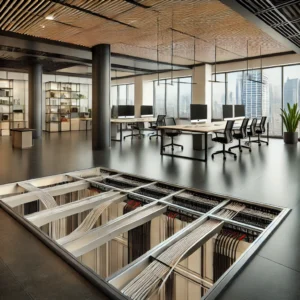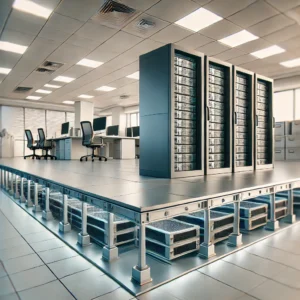Technical Benefits of Using Raised Flooring in Server Rooms
Raised flooring in server rooms offers numerous technical benefits, including enhanced cooling efficiency, organized cable management, improved airflow distribution, and increased safety. This innovative solution provides data centers with the flexibility to adapt to evolving IT infrastructure demands while maintaining a clean, efficient environment. Explore how raised flooring optimizes performance and ensures seamless operations for your server room.
Technical Benefits of Using Raised Flooring in Server Rooms
In modern server rooms, managing heat, cabling, and operational efficiency is crucial. Raised flooring systems have become essential for maintaining optimal conditions in server rooms and data centers. These systems create an elevated platform above the concrete subfloor, offering numerous technical advantages that improve functionality and safety. Below, we explore why raised flooring is a smart investment for server room infrastructure.
1. Enhanced Cooling Efficiency
One of the most significant benefits of raised flooring is improved airflow management. The underfloor space acts as a plenum for cold air distribution. This system directs cool air to server racks more efficiently, reducing the risk of overheating. It also supports hot-aisle/cold-aisle configurations, optimizing cooling systems and lowering energy costs.
2. Flexible Cable Management
Raised flooring simplifies cable management by providing ample space for routing power and data cables underneath the floor. This reduces clutter, minimizes trip hazards, and makes future upgrades or maintenance easier. With organized cabling, you’ll experience fewer interruptions and a more reliable IT infrastructure.
3. Improved Safety and Reduced Downtime
By keeping power and data cables concealed beneath the raised floor, risks such as tripping hazards, cable damage, and accidental disconnections are minimized. The raised floor also protects critical infrastructure from water damage and other environmental risks, ensuring uninterrupted operations.
4. Scalability and Adaptability
In fast-evolving IT environments, scalability is vital. Raised flooring makes it easy to adapt to new technologies and accommodate additional equipment without major construction. The modular panels can be removed individually, allowing for quick reconfiguration.
5. Better Aesthetics and Cleanliness
Server rooms with raised flooring maintain a cleaner, more organized appearance. Concealed cabling and strategic airflow contribute to a professional and tidy environment, which is essential for inspections and maintaining high operational standards.
6. Improved Equipment Lifespan
Proper airflow management and reduced exposure to dust and debris help extend the lifespan of servers and other critical IT equipment. By maintaining optimal operating conditions, raised floors contribute to fewer hardware failures and reduced maintenance costs.
Specifications Table: Technical Benefits of Using Raised Flooring in Server Rooms
| Specification | Details |
|---|---|
| Material Composition | Steel, Aluminum, Woodcore, Calcium Sulfate |
| Panel Dimensions | 600mm x 600mm |
| Floor Height | 150mm to 1200mm (customizable) |
| Load Capacity | 1,500 – 2,500 lbs per panel |
| Airflow Panels | Available with perforated designs |
| Fire Resistance | Compliant with industry standards |
| Antistatic Properties | Yes |
| Cable Management | Full underfloor cable routing |
| Cooling Optimization | Supports underfloor HVAC systems |
| Surface Finish | HPL, Vinyl, Carpet |
| Maintenance Access | Modular, easy to remove and replace panels |
| Moisture Resistance | High |
| Installation Time | Typically 3-5 days for standard rooms |
| Lifespan | 25+ years with proper maintenance |
| Warranty | 10 years standard |
5 Product FAQs with Answers
1. What is raised flooring in server rooms?
Raised flooring is an elevated floor system installed above a solid substrate to create a concealed space for cables, airflow, and other utilities, improving server room functionality.
2. How does raised flooring improve cooling?
The underfloor space acts as a plenum for cold air distribution, enabling efficient cooling by directing airflow directly to server racks and supporting hot-aisle/cold-aisle setups.
3. Is raised flooring customizable?
Yes! Raised flooring can be customized in terms of height, panel materials, surface finishes, and load capacity to meet specific server room requirements.
4. How does raised flooring improve safety?
Raised flooring reduces hazards by concealing cables and providing better protection against water damage, preventing tripping and accidental disconnections.
5. How long does it take to install raised flooring in a server room?
Installation typically takes 3 to 5 days, depending on the size and complexity of the server room.
Why Choose Raised Flooring for Your Server Room?
- Enhanced Performance: Optimizes cooling and airflow, improving server efficiency and reducing energy costs.
- Easy Maintenance: Modular panels provide easy access for maintenance and system upgrades.
- Future-Proof: Scalable and adaptable to accommodate evolving IT needs.
- Safe and Organized: Minimizes cable clutter and reduces the risk of accidents.
- Proven Reliability: Protects critical IT infrastructure from environmental risks and extends equipment lifespan.
Pros and Cons Table
| Pros | Cons |
|---|---|
| Improved cooling and airflow management | Initial installation cost can be high |
| Superior cable management | Requires professional installation |
| Reduces downtime and improves safety | Regular maintenance needed for optimal performance |
| Scalable and customizable | May raise overall floor height significantly |
| Enhances aesthetics and cleanliness |
|
|
|
|



